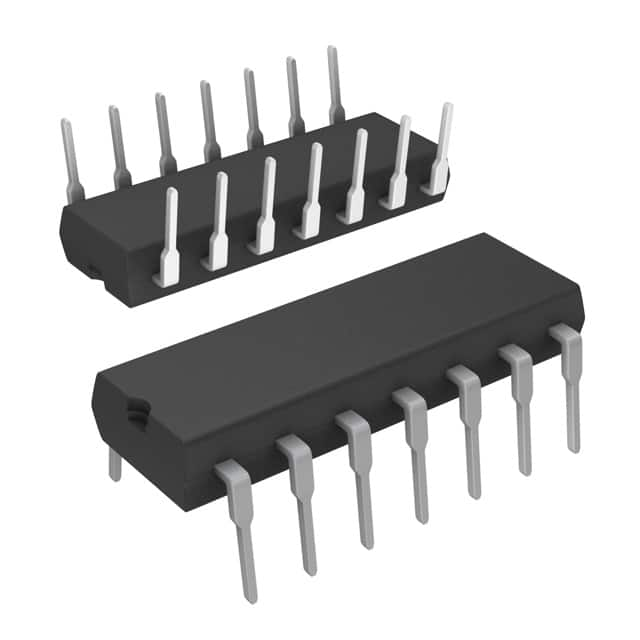MM74C906N
Product Overview
- Category: Integrated Circuit
- Use: Digital Logic IC
- Characteristics:
- Low-power consumption
- High-speed operation
- Wide operating voltage range
- Package: DIP (Dual In-line Package)
- Essence: This integrated circuit is designed for digital logic applications, providing low-power and high-speed operation in a wide voltage range.
- Packaging/Quantity: Available in tubes or reels, with a quantity of 25 units per tube/reel.
Specifications
- Supply Voltage Range: 2V to 6V
- Operating Temperature Range: -40°C to +85°C
- Logic Family: CMOS
- Number of Pins: 14
- Input/Output Compatibility: TTL/CMOS
Detailed Pin Configuration
The MM74C906N has a total of 14 pins, which are assigned specific functions as follows:
- VCC: Supply voltage input
- GND: Ground reference
- A0: Address input bit 0
- A1: Address input bit 1
- A2: Address input bit 2
- A3: Address input bit 3
- CE: Chip enable input
- OE: Output enable input
- I/O0: Bidirectional data input/output 0
- I/O1: Bidirectional data input/output 1
- I/O2: Bidirectional data input/output 2
- I/O3: Bidirectional data input/output 3
- I/O4: Bidirectional data input/output 4
- I/O5: Bidirectional data input/output 5
Functional Features
- 6-bit bidirectional I/O port
- Non-inverting data path
- High noise immunity
- Schmitt trigger inputs for improved noise rejection
- Low power consumption
- Wide operating voltage range
Advantages and Disadvantages
Advantages: - Low power consumption makes it suitable for battery-powered devices. - High-speed operation allows for efficient data processing. - Wide operating voltage range provides flexibility in various applications. - Schmitt trigger inputs enhance noise rejection, ensuring reliable operation.
Disadvantages: - Limited number of I/O pins (6-bit) may restrict its use in complex systems requiring more I/O ports. - DIP package may not be suitable for space-constrained designs.
Working Principles
The MM74C906N is based on CMOS technology, which allows for low-power operation. It functions as a 6-bit bidirectional I/O port, enabling the transfer of digital data between a microcontroller or other digital logic circuits. The chip operates by receiving address inputs to select the desired I/O port and control signals to enable/disable the chip and control the direction of data flow.
Detailed Application Field Plans
The MM74C906N can be used in various applications, including but not limited to: - Microcontroller-based systems - Data communication devices - Industrial automation - Consumer electronics - Automotive electronics
Detailed and Complete Alternative Models
- SN74HC595: 8-bit shift register with output latches
- CD4017: Decade counter/divider with 10 decoded outputs
- 74LS138: 3-to-8 line decoder/demultiplexer
- CD4060: 14-stage ripple carry binary counter/divider
These alternative models offer similar functionality and can be considered as alternatives to the MM74C906N depending on specific application requirements.
Word count: 409 words
Lista 10 Vanliga frågor och svar relaterade till tillämpningen av MM74C906N i tekniska lösningar
Sure! Here are 10 common questions and answers related to the application of MM74C906N in technical solutions:
Q: What is MM74C906N? A: MM74C906N is a specific integrated circuit (IC) chip used for various technical applications.
Q: What are the main features of MM74C906N? A: MM74C906N features include low power consumption, wide operating voltage range, and multiple input/output pins.
Q: What are some typical applications of MM74C906N? A: MM74C906N can be used in applications such as digital systems, microcontrollers, data acquisition systems, and industrial automation.
Q: How does MM74C906N help in digital systems? A: MM74C906N provides digital signal processing capabilities, enabling tasks like data conversion, signal conditioning, and control functions.
Q: Can MM74C906N be used with microcontrollers? A: Yes, MM74C906N can interface with microcontrollers through its input/output pins, allowing it to perform various functions in conjunction with a microcontroller.
Q: Does MM74C906N support analog inputs? A: No, MM74C906N is primarily a digital IC and does not have built-in analog-to-digital conversion capabilities.
Q: What is the operating voltage range of MM74C906N? A: MM74C906N typically operates within a voltage range of 2V to 6V, making it compatible with a wide range of power supply configurations.
Q: Can MM74C906N be used in battery-powered devices? A: Yes, MM74C906N's low power consumption makes it suitable for use in battery-powered devices, helping to extend battery life.
Q: Are there any specific precautions to consider when using MM74C906N? A: It is important to follow the manufacturer's datasheet and guidelines for proper handling, voltage levels, and temperature limits to ensure reliable operation.
Q: Where can I find more information about MM74C906N? A: You can refer to the manufacturer's datasheet, online technical forums, or contact the manufacturer directly for more detailed information about MM74C906N.


